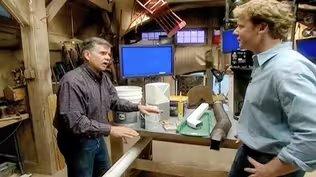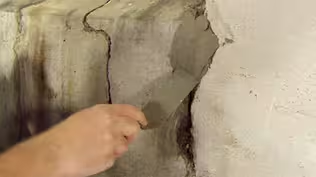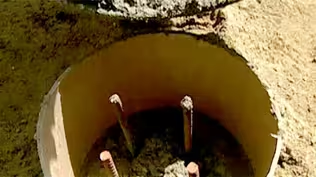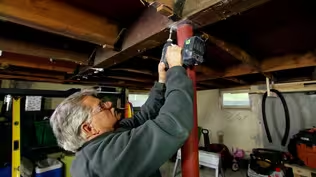
E3 | Nashville Brick Cottage | Grounded
Season 46 Episode 3 | 23m 42sVideo has Closed Captions
Prefabricated walls are in place. The house is moved off the cribbing onto the foundation.
The episode opens with the house still in the backyard. While planning the prefabricated foundation walls to be set, an issue comes to light. Structural engineer, Michael Vines is onsite to solve the problem. Kevin O'Connor and Tom Silva try Nashville's famous hot chicken to celebrate. Later, house mover expert Don Toothman safely moves the house back over the new foundation.
Problems playing video? | Closed Captioning Feedback
Problems playing video? | Closed Captioning Feedback
Funding for THIS OLD HOUSE is provided by The Home Depot and Renewal By Andersen.

E3 | Nashville Brick Cottage | Grounded
Season 46 Episode 3 | 23m 42sVideo has Closed Captions
The episode opens with the house still in the backyard. While planning the prefabricated foundation walls to be set, an issue comes to light. Structural engineer, Michael Vines is onsite to solve the problem. Kevin O'Connor and Tom Silva try Nashville's famous hot chicken to celebrate. Later, house mover expert Don Toothman safely moves the house back over the new foundation.
Problems playing video? | Closed Captioning Feedback
How to Watch This Old House
This Old House is available to stream on pbs.org and the free PBS App, available on iPhone, Apple TV, Android TV, Android smartphones, Amazon Fire TV, Amazon Fire Tablet, Roku, Samsung Smart TV, and Vizio.

This Old House Insider Newsletter
Get This Old House exclusive stories, tips, and behind-the-scenes information delivered right to your inbox every month.Providing Support for PBS.org
Learn Moreabout PBS online sponsorshipKevin: Today on "This Old House"... Tom: These 10-foot precast panels have arrived to the jobsite, and when they go in, they'll transform that basement into great living space.
Kevin: And then the house is going to move back into place over its new foundation.
It's a little unnerving.
Tom: Oh, yeah.
♪♪ Man: Ahh.
That's it.
♪♪ ♪♪ ♪♪ ♪♪ Kevin: Hey there, I'm Kevin O'Connor, and welcome back to "This Old House" and to Tennessee, where we are working on a project in this beautiful little East Nashville neighborhood that was built around the turn of the century.
You can see it's got an eclectic mix of homes.
We've got a little brick bungalow right here, and then we have our house, which you can't get into right now because it is 10 feet above the ground.
That little brick cottage was built in 1929, and we are renovating it for our homeowners, Adam and Rachel, and their two children.
And they're going to go back to the studs and they're going to add some extra living space.
Right now, all the bedrooms and bathrooms are on the first floor, so they are going to bump it up onto the second floor with a dormer off of the back, and they're going to pick up some extra height room in the basement.
And those two things are going to give them a lot of extra living space without changing the footprint at all.
And that is very much smiled upon here in this historic district.
Now, you may recall, last time we were here, we jacked the house up off the foundation.
We put in a network of steel beams, and then the house was rolled into the backyard, set down on the temporary cribbing.
And that gave us access to the old foundation, which was made out of block, and that is all going away because we're bringing in a brand-new precast concrete foundation.
And that'll do the two things we need.
It'll raise up the basement for full head height, and it will support the extra weight of that second story.
And it looks like Mr. Silva and our GC Javier are down in the pit with the boys, getting ready to prep the site.
So, our pit is about 43 wide, 30 deep, and at its highest point about 10 feet below grade.
Javier, how are you?
Javier: I'm good, and you?
Kevin: Tommy, good to see you, fellas.
So, excavation is done?
Javier: Yes, sir.
Kevin: Not without a lot of work, though, huh?
Javier: We sure do.
So now, once you see that we got all this out of the way, we were this close to getting to our grade, and then we've hit this little tiny rock that you see.
Kevin: So you were digging down and you found ledge?
Javier: We found this stone that takes, like two thirds of the house.
So we had to big -- bring big equipment.
And as we were hammering, it was so big that the neighbors across the street could feel it.
Kevin: Good morning!
Tom: [ Laughs ] Javier: I know, right?
So, after we got that done, we got all of our stakes pinned for our corners.
The guys that are going to set the walls are here.
Kevin: Yeah.
Well, we appreciate all the work and getting it done.
And so now we're moving forward, Tommy, and where do we go from here?
Tom: Alright, now they're getting the drainage pipe put in.
And what we need to do is we don't want the front wall of the foundation to be a dam.
Kevin: Right.
Tom: So when it rains and stuff like that, you want the water that enters the front of the foundation to go down and under the slab.
Kevin: So just around the perimeter wouldn't be enough, you're saying.
Tom: Right, because of this, the footing for this foundation is basically crushed stone or broken stone.
Kevin: Yeah, yeah.
Tom: So if you look right there that's crusher run right there.
That's compacted.
I mean, look at how hard that is.
Kevin: Yep.
Gotcha.
Tom: Alright?
And then on top of that they're going to put the broken stone on a trap stone right here.
And if you look at it, it's all sharp edges and you want that in place of peastone.
You don't want a rounded stone.
That's because when these go in and it gets tamped, these lock together and they won't move when the foundation is on it.
Kevin: So a network of drainage pipes, two layers of stone, get everything layered off, compacted, and then we'll be set for those precast concrete panels.
Tom: Yep.
Exactly.
Javier: Yes, sir.
Kevin: Let's get to putting them in.
Let's do it.
Tommy, that's quite a machine.
Tom: Oh, yeah.
I mean, that truck basically is a hopper.
And in the bottom of the hopper, there's a conveyor belt so he can control the speed, which means the faster it is, the further they can throw the stone.
Kevin: How far can he throw anything?
Tom: Up to about 125 feet, he said.
Kevin: Very nice.
Tom: It's pretty good.
Kevin: They may bury us down if we don't get out of the way.
♪♪ Tom: He said he might be able to empty that truck in about 20 minutes, high speed.
And it's only 22 ton.
Whew!
That's a lot of stone.
♪♪ ♪♪ Kevin: Alright.
Got the stone up to the right height.
Tom: Yeah, they shot it all in.
Right now they have the steel pipes in the ground.
They use a steel screen that they can drag from metal to metal, slide it across and make it nice and level.
So when the panels come in, they'll have a nice level surface to sit on.
Kevin: So up to elevation out here.
But we're still low in the middle.
Why is that?
Tom: Well, if you think about it, this is actually pretty smart to leave it down low because there's a few things that has to happen.
There's a couple of footings that have to be put in for some lally columns.
There's also a footing that has to be put in right about here for the chimney.
And there's plumbing that's got to go into the floor too.
Kevin: Ah.
Tom: So rather than lay it out, dig it out, it's already they can put it in and get it inspected and backfilled.
Kevin: Alright.
So that makes sense.
But then I'm looking at this back here and this is still low.
So where are we putting the panels here?
Tom: Well, there's no panels going here.
The three walls right here, the front and the two sides, are all below grade.
Kevin: Yeah.
Tom: Out back, this grade's coming down and basically going to walk out.
Kevin: It's gonna be a walkout basement.
Tom: Walkout basement.
For that situation, we get an engineer involved because of the situation with the house.
Kevin: Alright, well, I guess I've got a conversation with an engineer in my future.
Tom: You sure do.
Kevin: Good to see that the crane is here.
It means the panels can't be far behind.
Tom: Yeah, panels should be here shortly.
Kevin: Alright.
♪♪ ♪♪ Hey, Michael.
Kevin.
Nice to meet you.
Michael: Hi, Kevin.
Kevin: So, Tommy tells me that you re-engineered our fourth wall for us.
Michael: Yes, sir.
Originally, we were going to have precast walls on all four sides of the house.
Kevin: Right.
Michael: But due to the number of steel beams that were used to raise and move the house, that's created some conflicts that brought us some concern.
Kevin: Ah.
Michael: So we have to coordinate where those beams are located with the precast panel walls so they can block out an opening for when they drop the house down, it'll fall into those openings.
Kevin: So I heard that plan, that each panel was going to have sort of a pocket built into it so that you can drop it down, you know, and that needle would go in there.
If that works for the front of the house, why doesn't it work for the back of the house?
Michael: Well, the main issue on the back of the house is, as you can see on the elevation, there's three door openings in the back wall.
Kevin: Oh.
Michael: Each one of those door openings has a concrete header or would have a concrete header formed into that precast panel.
Kevin: Gotcha.
Michael: Where we need these openings to be formed into the wall, that interrupts the header.
So we've had to go a different route.
Kevin: So you're saying we couldn't get both the concrete header and the pockets for these needles?
Sort of one or the other?
Michael: Yes, sir.
That's correct.
Kevin: So what is the plan for the back wall?
Michael: So, they'll go ahead and set the precast concrete panels on three sides of the house today.
Then they'll start preparing to pour the slab on grade in the basement and forming a monolithic slab along the back wall.
Then the back wall will be a traditionally framed 2x6 stud wall.
Kevin: Gotcha.
Okay.
But we still can move this house back pretty quickly, right?
Michael: Yes, sir.
I believe the plan is to move it back into place tomorrow and then provide temporary shoring while the rest of the work is being completed.
Kevin: Awesome.
Alright, well, thank you, Michael.
Appreciate it.
Michael: Thank you.
♪♪ Tom: These panels are made in a factory about 100 miles away, loaded onto the truck, trucked to the site.
They're going to back in, and they're going to install them with a crane.
In a few hours, about three quarters of the foundation will be in place.
♪♪ ♪♪ ♪♪ Alright.
They just set the first panel, and you notice that he bolted it to the ground right here.
He drilled into the ledge below and fastened the bolts to it.
This diagonal bracing holds this wall exactly plumb, so it won't fall on anybody when they're in here.
But these panels are really nice.
I mean, if you think about it, it's a precast foundation system.
The concrete is a 5,000 mix and it's about two inches thick.
And then there's 2 1/2 inches of foam right here.
There's also steel reinforced columns all the way down.
And the columns are also drilled for the electrician so he can run his wire through it.
And it has a little nailer on here or a screwing.
So if you want to put your drywall or any kind of finishes on it, you can do that.
And if you want to add more insulation to it, easily done right here.
You can fill that cavity.
Kevin: Gotcha.
Tom: Now, these are specialized for the jobsite.
Because of all the needles in the walls to hold the house up, well, they had to make openings all along.
They added studs when needed.
They put more concrete in and more insulation to make up for that difference.
Kevin: Beautiful.
Tom: So they're really straight and strong.
Kevin: And obviously second one's going here in the corner.
They got a little miter there that comes together.
Tom: And they seal that miter.
And there'll be two bolts, one on the top and one on the bottom.
They'll slide in a pocket and then they'll bolt that sucker together.
And then once it's in place, they'll put two beads, one in the outside and one in the inside of the miter.
That's not going to leak and it's not going to come apart either.
It really holds well.
♪♪ ♪♪ Takes a crowbar and he jams it under the stone, and he can actually work it right on to the line that's on the outside where it has to be.
That's called fine-tuning a heavy wall.
Alright.
They just picked that three and a half return wall that goes on the back.
They'll bring that around.
It'll hold these walls together and they won't fall down.
And if you look right there, there's one of the provisions for the steel rod to go through.
Go all the way through the miter and bolt them nice and tight.
♪♪ Alright.
This is the last of the front panel going in.
The operator of the crane, he's being told what to do with hand signals.
Boom down, boom in, left, right, up, over, stop.
All of those things the driver understands, the movement of the arm and everything else.
Now he's bringing and swinging it over and he's going to drop it on the line.
♪♪ And the crew keeps going, laying the panels on the east side of the house.
♪♪ ♪♪ On spot.
Just like that.
Kevin: I don't know, Tommy.
That is really satisfying.
I mean, just about three hours, a little under, and we've got all of this done.
Tom: It's amazing.
I mean, if we were to pull this, pull the footings, form it, pull the walls, then insulate and stud and all that, it'd be a week.
Kevin: Yeah.
And now we've got, you know, we've got the foundation, but plus we got everything else.
Tom: Yep.
All we got to do now is set the sill and the house can come back and lay down.
Kevin: Cannot wait to see dawn tomorrow.
Tom: Same here.
Kevin: Our old friend.
♪♪ Nashville, home to the Grand Ole Opry, Centennial Park, and the birthplace of its famous hot chicken.
I'm told you can't come to this town without trying its devilish signature dish, a dish created almost 100 years ago and all because of a woman scorned.
As legend has it, Thornton Prince, the godfather of hot chicken, a notorious ladies' man, came home late one night, much to the chagrin of his partner.
Today, we're taking a break from the jobsite to see if we can take the heat and to meet Thornton's great niece.
And, well, I guess I'll let her explain the rest.
Andre: So what other way can you get back at somebody?
You get back with them -- at them through their food.
So more than likely that's what she did.
Tom: So she spiced up the chicken.
Andre: She spiced it up and he loved it.
"Wow, he's going to have a reaction."
Kevin: Alright, well, we're looking forward to trying it.
Thank you for having us in.
Andre: Thank you for coming.
Tom: Nice to meet you.
Andre: [ Laughs ] Woman: Hello.
Kevin: Oh.
Thank you.
Tom: Oh, boy.
There we go.
Woman: There's plain.
Kevin: Okay.
Tom: That looks good.
Kevin: The least hot right there.
Woman: Next we have mild.
Kevin: Coming in.
Woman: Medium.
Kevin: Ooh, it's getting darker.
[ Laughs ] Woman: And here is hot.
Last but not least, here is the XXX hot.
Kevin: Thank you.
Woman: You're welcome.
Enjoy.
Tom: Alright.
Are you ready, sonny?
Kevin: Yeah.
Yeah.
Tom: That's where I'm starting.
Kevin: Plain right there.
Tom: I'm gonna take one of those pickles.
I might need it.
That is tender and moist.
Kevin: Mmm.
Tom: The flavor is great.
Kevin: No heat.
No, heat on that at all.
Well, I got to at least get the medium.
You want me to go first and give you a report?
Tom: Go for it.
Kevin: Oh, yeah.
Get it right away.
Whew!
Tom: Got a bite.
Kevin: Peppery.
Tom: Good though.
Kevin: Uh-oh.
Tom: Got a good flavor.
Kevin: That was full of flavor.
Hang on.
What are we, halfway there?
I'm good.
Good at medium, Tommy.
Tom: I like the medium a lot.
Kevin: Listen, pops, I'll carry your bag for a week... [ Both chuckle ] ...if you go that.
Tom: Well, if you'll carry it for a week, then I might have to take you up on it.
Kevin: If you go there.
♪♪ Tom: Mmm.
Kevin: How's the heat?
Tom: It's coming.
Kevin: [ Laughs ] Tom: I got to say, I'm definitely starting to feel it.
Maybe even a little tear coming.
[ Laughs ] Kevin: Aww.
Our house mover is Don Toothman, and you can see that his crew has been busy.
Tom: Well, Don, it's looking good.
Are you ready to go?
Don: We're getting there.
Kevin: That's alright.
So I noticed the carpenters put the wood sill on top of the foundation.
What's your process for getting the house back over here?
Don: Well, we'll have to set up skate beams and skate halfway, then reset, then skate it again, and then line up over our slots in the walls.
Kevin: So remind me.
The skate beams, these big ones here.
Don: These big ones on the bottom, yes.
Kevin: But the beams that you're going to actually roll this out on?
Don: Yes.
Kevin: Very cool.
Tom: You want to make sure the top of the steel beams are really clean.
A speck of sand can make a difference in the rollers.
Kevin: Alright, well, we'll watch you move this house.
Don: Alrighty.
Tom: So right now the house is resting on two, four, six, eight jacks.
And it's just basically a post.
Kevin: Yeah, it's not a lot of surface area.
Tom: So you think about it like this.
It's -- This is probably the most tricky part right here.
So now that they put the jack up, they're going to infill it with more cribbing so they can take the jacks down but really stabilize everything.
So then when they pull on these beams to get them out of here it doesn't knock anything over.
Alright.
So he's using a bottle jack right here.
What he wants to do is he wants to take the load off of this cribbing right here to create a space to put a roller in there.
He'll slide the roller right in there.
That beam is going to roll on that.
This beam right here is a little over 7,000 pounds for this one beam.
And these guys are going to roll the beam and pull it forward all by hand.
[ Man shouting in Spanish ] Going out over that cribbing right there in the front.
You can see.
Get beyond that.
They're going to bring it in as far as they can.
Then they're going to reposition everything.
Man: Okay.
It's good.
Tom: Alright.
So what they're trying to do now is they don't want that beam to be exactly level this way.
They want to have an ever so slight pitch downhill, first of all, so the house doesn't roll back, make it a little easier for them to push forward, but they don't want to have it to go too fast so they can't stop it.
Hey, Don, first beam set.
Don: First beam set for the first roll.
Tom: Yeah.
Don: Getting ready to move the other one up to the same position.
We'll roll it on these two cribs.
Tom: Yeah.
Don: And then we'll reset one more time.
♪♪ ♪♪ Tom: Good.
Ooh!
That wasn't too bad.
With our escape beams in position, Don can now bring in the winch truck that will pull the house back over its new foundation.
Alright, so Don's got the cable set through the snatch block that's on a chain connecting it to the truck.
Then they connect that with a chain.
Don: You got enough chain?
Man: Yeah.
Don: Okay.
Tom: Don's getting ready to let the pressure off of the jacks, so the house will sit on the rollers, and then he can activate the winch.
Don: She's ready, Carlos.
Tom: Now, this is going to move pretty slow, but if you watch the cable on the top of the foundation, you'll see it moving past the sill.
Nice and easy.
Don: Ready, Carlos?
Carlos: Yeah.
Kevin: Does it ever make you nervous?
Don: Oh, not really.
They just had to get some bigger hammers now.
[ Laughter ] Tom: Se how the snatch block is working.
You can see the cable coming through.
It's rotating so that you can see how slow they're moving it.
They're still banging the trolleys in there.
They want to steer the house.
If he bangs to the left and the guy in the back bangs to the right, they're turning the house.
Kevin: It's a little unnerving.
Tom: Yeah.
We're over the foundation.
It's not a lot of clearance, but there's enough to get it by.
♪♪ ♪♪ Alright, Don's getting ready to let the house down.
But he has to do one thing first before he can go down.
These beams right here, well, there's two of them that when they come down, they're going to hit the pocket.
So he has to move the whole house this way a half an inch.
To do that, the rollers have been turned on top of the skate beam.
So now he can push the house left or right.
He's going to take the track machine.
He's going to put the fork right there.
And on the end of that beam, he's going to push it.
Now see the gap?
Carlos has got it against the wall.
See it going in?
Closing the gap, filling it in.
[ Man shouts indistinctly ] Right there.
He just told them to stop.
Now they can check the alignment to make sure all the needles are going to fit in without hitting the sides of the pockets.
What they're going to do is they need to jack the beam up and get these two main beams or the whole house off of the skate beams, so they can take the dolly out and lower it, repossessing the jacks, and then set it in place.
A lot to it.
Getting closer.
[ Metallic banging ] Here it comes.
I can hear the creaking.
Kevin: House has got rhythm.
Tom: [ Laughs ] And see the beam.
The steel beam that's going to come out.
That's going right into the pocket that was allowed.
So that'll get in and dropped.
And now all the needles are starting to fit into place.
Man: You're good.
Perfect.
Kevin: There it is.
Tom: I got to say, it looks pretty good, Don.
What do you think?
Are you happy with it?
Don: Oh, I'm tickled to death.
We just got to tweak it a little bit and get it ready for Javier and be good to go.
Kevin: Alright, so, Javier, what's next for you once the steel gets out?
Javier: Now that the steel come out, we'll get our plumbers, let them do their rough end, hopefully get our inspections pretty soon, and then prep for the slab while in the back and let Mr. Don do his thing after that.
Kevin: Awesome.
Alright.
Sounds good.
Don, thanks for all the help.
We appreciate it.
Don: It's been a blast.
Kevin: Alright.
Well, we got all that and more coming up next time.
So for all of us on "This Old House," I'm Kevin O'Connor signing off from East Nashville, Tennessee.
How good does that feel, huh?
Javier: It was amazing.
[ Laughter ] Kevin: Hey, Don, how about just taking a little to the left?
[ Laughter ] Tom: He can do it.
Kevin: Next time on "This Old House"... A plumbing penetration is one of the most vulnerable places on a roof, so we are going to seal them up and blend them in.
Richard: Then we'll reveal how the homeowners are going to heat and cool this century-old building.
Tom: And we'll take a trip to country music's biggest stage and talk to one of its biggest stars.
Trisha: I have a nail gun and I have a drill.
Jenn: Fantastic.
Trisha: I bring my own tool belt.
So just -- Just so you know.
Jenn: I think Tommy -- Trisha: I'm just putting it out there.
Just putting it out there, guys.
Support for PBS provided by:
Funding for THIS OLD HOUSE is provided by The Home Depot and Renewal By Andersen.

















